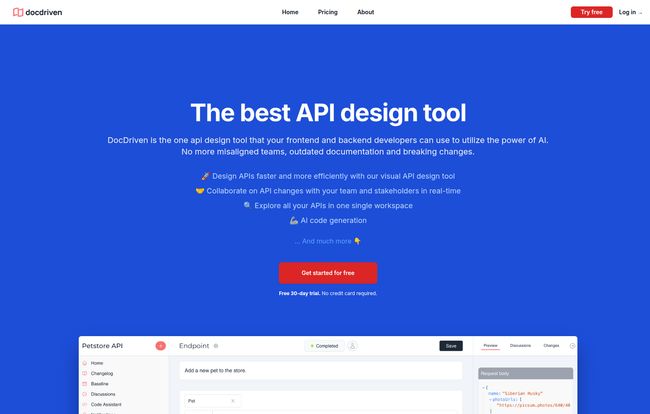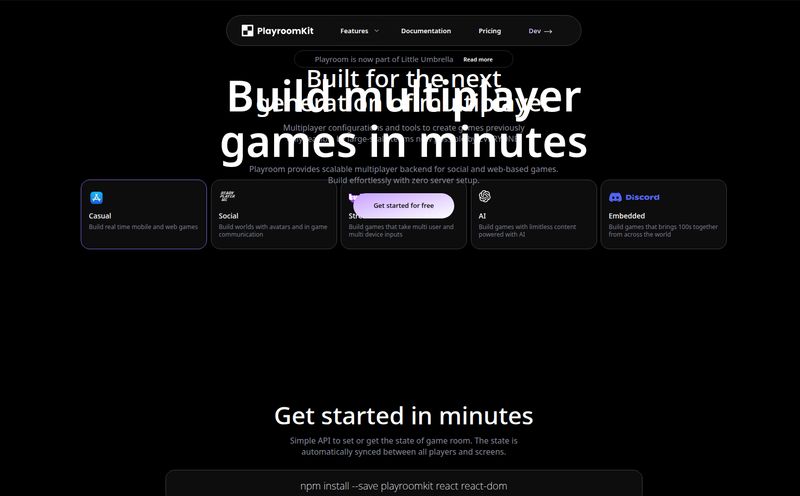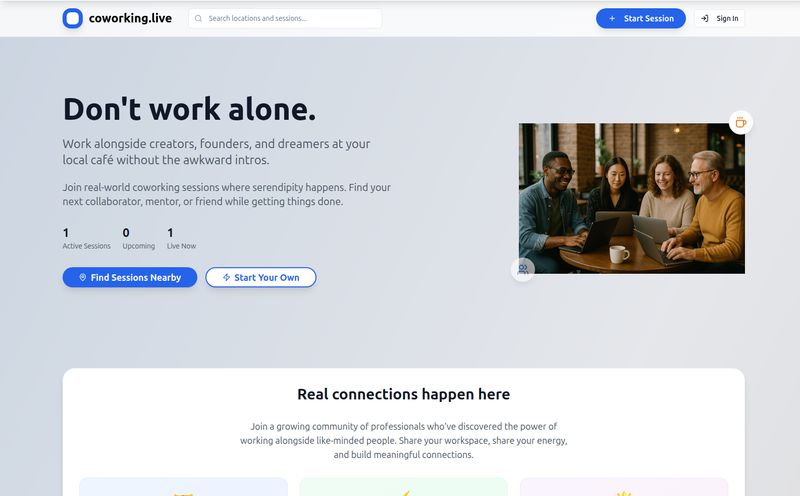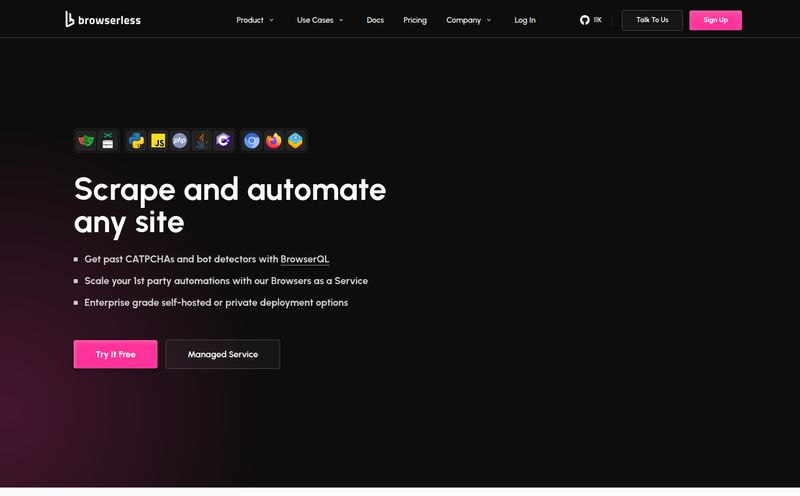If you've spent any time in software development, you've seen the battlefield. It’s that tense, silent space between the frontend and backend teams. The backend folks swear the API is crystal clear. The frontend devs insist they're working off documentation from the stone age. And the project manager? They're just trying to keep the release date from slipping into the next quarter.
It's a classic story. A tale as old as time, or at least as old as REST APIs. Miscommunication leads to bugs, which leads to delays, which leads to everyone being just a little bit more grumpy on Monday morning. I've lived it. You've probably lived it too. We've tried wikis, we've tried endless Slack threads, we've tried giant Postman collections that become outdated the second you export them.
So when I stumbled across a tool called DocDriven, which markets itself as a 'visual API design tool with AI,' my inner cynic and my inner optimist had a little argument. The cynic scoffed, 'Another magic bullet?' But the optimist, the part of me that still believes we can make this whole process better, leaned in. And I'm glad it did.
So, What Exactly is DocDriven?
In a nutshell, DocDriven is trying to be the single source of truth for your API. Think of it less like a dry documentation tool and more like a shared, interactive blueprint for your application's data layer. It’s a platform where your frontend and backend teams can meet, design the API together in a visual way, and stay perfectly in sync without having to translate their work for each other.
The whole idea is to stop APIs from being this abstract concept that lives in code and turn it into a concrete, visual thing that everyone—from the junior frotnend dev to the senior backend architect to the non-technical PM—can actually understand. It's like a UN translator for your tech stack.

Visit DocDriven
The Great Divide DocDriven Wants to Bridge
The tool's entire existence is based on solving a very real, very human problem. The landing page nails the pain points so well, it feels like they've been secretly listening in on my sprint planning meetings.
For the Backend Crew
You know the drill. You build what you think is a perfectly logical endpoint. Then the questions start. 'What does this field mean?' 'What's the data type for that object?' 'Can you send me a sample response?' DocDriven aims to cut that out by making the design so clear and interactive that the API essentially documents itself. No more being a human FAQ for your own code.
For the Frontend Team
Oh, the agony of building a beautiful UI component, only to find out the API you were promised doesn't exist yet, or worse, it works completely differently than you were told. DocDriven tackles this with real-time mock servers that are generated directly from the API design. This means frontend can build and test against a reliable mock that perfectly mirrors the final product. It's a game-changer.
And for the Anxious Product Managers
For PMs, the nightmare is a last-minute surprise. The 'Oh, by the way, the API changed and now the entire checkout flow is broken' surprise. By keeping everyone on the same page and flagging breaking changes automatically, DocDriven acts like a project insurance policy. It helps ensure that what gets designed is what gets built, and what gets built actually works together.
My Favorite Features (The Real Meat and Potatoes)
Okay, let's get into the nitty-gritty. What makes this thing tick? I’ve seen a lot of tools, and a few of DocDriven’s features really stand out to me.
"The goal isn't just to write documentation; it's to create a shared understanding. That's the difference between a text file and a collaborative tool."
- The Visual Editor: Honestly, this is the main draw. Instead of wrestling with YAML or a clunky interface, you're dragging and dropping, defining models, and setting up endpoints in a way that just makes sense visually. It lowers the barrier to entry, so you dont have to be a backend wizard to contribute to the API design.
- AI Code Generation: Now this is the buzzy part. DocDriven uses AI to generate boilerplate code for your API directly from the visual design. Is it going to write all your complex business logic? Of course not. But what it will do is handle the repetitive setup, the type definitions, the basic controllers... all the stuff that takes time but not a lot of brainpower. You still need a human to review and refine it, but as a starting point? It's pretty magical.
- Automatic Changelogs: Remember that pain of outdated docs I mentioned earlier? This feature is the cure. Every time the API design is changed, a changelog is automatically generated. No more forgetting to document a tiny tweak that ends up breaking the mobile app. It’s accountability by default.
- Real-Time Mock Servers: I touched on this, but it's worth repeating. This feature decouples your teams. The frontend doesn’t have to wait for the backend to be finished. They can start building with a live, interactive mock server from day one. This alone can shave weeks off a project timeline. It's a huge win for development velocity.
Let's Talk Money: DocDriven Pricing
Alright, the all-important question: how much does this digital peace treaty cost? The pricing model is refreshingly straightforward, which I always appreciate.
| Plan | Price | Best For |
|---|---|---|
| Free 30-day trial | $0 | Anyone wanting to kick the tires without commitment. You get all the features on a single workspace. |
| Team | $14.25 / user / month | Small to medium-sized teams and companies that need multiple workspaces and unlimited collaboration. |
| Enterprise | Custom Pricing | Large organizations with advanced needs like custom payment terms, priority support, and dedicated onboarding. |
My take? The pricing is very reasonable. The fact that the trial is 30 days and requires no credit card is a massive green flag. It shows confidence in the product. For a small team of, say, 4-5 developers, the Team plan is a pretty small investment for the amount of time and headaches it could save.
The Catch (Because There's Always a Catch)
Okay, so it's not all sunshine and automatically generated code. No tool is perfect, and from my analysis, there are a couple of things to be aware of.
First, there's going to be a bit of a learning curve. If your team is used to a code-first, Swagger-heavy workflow, switching to a visual-first tool requires a mental shift. It's an investment in a new process, not just a new piece of software.
Second, as I mentioned with the AI, you can't just blindly trust the generated code. It's a powerful assistant, but it's not a replacement for a skilled developer. You still need to own your codebase. Think of it as a very smart intern—it gets you 80% of the way there, but you need to do the final review and add the critical business logic.
Who Is This Tool Really For?
So, who should be rushing to sign up for the free trial? In my opinion, DocDriven hits the sweet spot for a few groups:
- Growing Startups and Scale-ups: Teams where communication lines are starting to get strained and processes need to be formalized.
- Agencies: Juggling multiple projects and teams? A tool like this can standardize the API process and make handoffs smoother.
- Any Team Adopting an API-First Approach: If you're serious about treating your API as a first-class product, a design and collaboration tool like this is practically a requirement. It forces the right conversations to happen before a single line of code is written.
Frequently Asked Questions About DocDriven
- How does the 30-day free trial work?
- It's simple. You get 30 days of access to all the features on a single workspace. No credit card needed upfront. At the end of the 30 days, you'll need to pick a paid plan to continue.
- What happens when my free trial ends?
- Your account is put on hold. You won't lose your work, but you'll need to select a plan and enter payment info to get back in and keep using the tool.
- Can I import my existing OpenAPI or Swagger specs?
- Yes, according to their site's FAQ, they support importing OpenAPI specifications. This is huge, as it means you don't have to start from scratch if you have existing API documentation.
- Do I need to be a coding genius to use it?
- Definitely not. While developers will get the most out of the code generation, the visual editor is designed to be intuitive for project managers, UI designers, and QA testers to understand and even contribute to.
- Is the AI Code Generation actually reliable?
- It's reliable for generating the foundational code—models, basic endpoints, type definitions. It's not designed to write your unique, complex logic. Use it as a powerful accelerator, but always have a human developer review and build upon its output.
So, What's The Final Word?
Look, I've seen dozens of 'game-changing' dev tools over the years. Most of them are just a new coat of paint on an old idea. DocDriven feels different. It's not just focused on the code; it's focused on the humans writing the code. It tackles the squishy, difficult, and frankly more important problem of communication.
It won't magically solve all your problems, but it provides a framework and a shared space to prevent those problems from ever happening in the first place. For any team that's felt the pain of API misalignments, it’s more than just a tool. It’s a step toward a saner, more collaborative, and faster way of building software. And for that, it gets a serious nod of approval from me.
Reference and Sources
- DocDriven Official Website
- DocDriven Pricing Page
- API-First Development by Martin Fowler - A great read on the philosophy behind tools like this.



